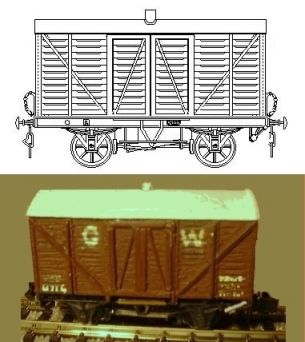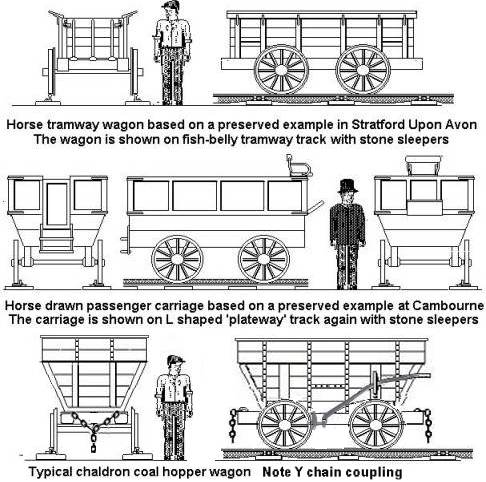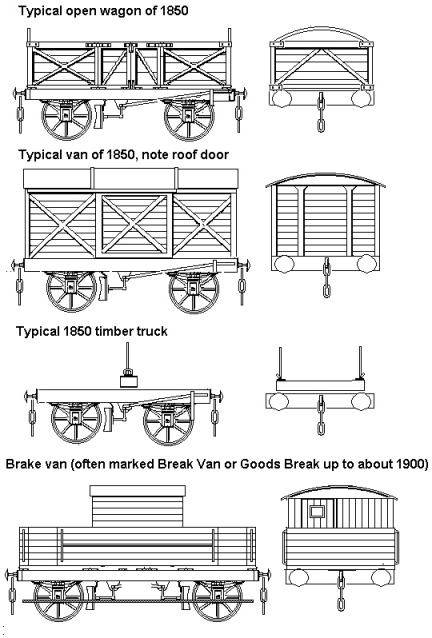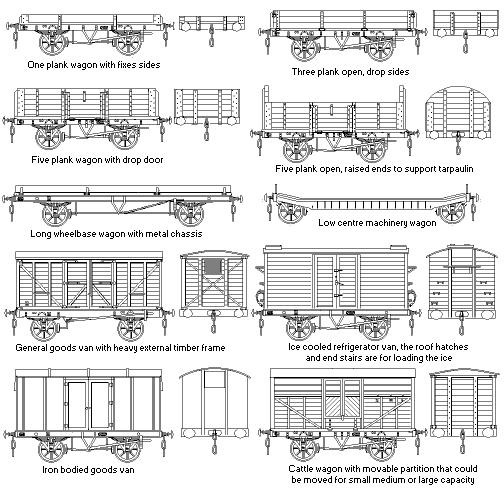One of the difficulties of railway modelling is picking appropriate rolling stock. First you have to decide on a date and location, then select wagons and liveries which existed at that date and might be seen in that location. There are books detailing the rolling stock built by the various companies and with a little work you can modify existing models and kits to produce variants and unusual wagon types. The problem here is one of numbers; the reference books show one or two pictures of each design, whether they were produced in tens or hundreds, in some cases only a single example of a particular wagon type was built.
Another problem is that of operational practice, having wagons in places where they might actually be seen. An example dear to the hearts of many modellers would be the railway beer wagons, used to transport barrels of beer from the breweries. These vans would usually travel in groups however, so you would need to make up at least three or four which is a long job. This kind of wagon would be quite restricted in its movements, built for a specific service they would not be used to take beer to a branch line station for the local pub.
Finally there were many changes in design introduced over the years which offer numerous traps for the unwary. Vans built before the 1930's generally had the frame timbers on the outside and some nineteenth century vans had short tubular 'lamp pots' on the roof which were the chimneys provided for oil lamps. An example of such a wagon is the early GWR fruit van with outside framed doors and a single lamp pot on the roof. A model of this van can be made from a standard Peco Vent Van kit and this is described in the section on Kit Bashing. Over the years versions of this van appeared in both grey and brown livery.
Fig ___ Early GWR fruit van

From reading the general literature you might assume that by the mid 1920's the lamp pots on the roof would have been removed, and the doors would have been changed to the inside framed type (as seen on the Peco GWR van) soon after 1927. In fact these nineteenth century vans (among the very first fruit vans built) continued in use, unaltered other than for livery, into the 1950's. The model is based on the Peco 'ventilated van' but these vans did not have the hooded vents on the ends so they need to be trimmed off and they had flat strapping in the form of an C across the end of the wagon. If I build any more I will use a Peco 'standard van' with sides cut from a Peco 'Ventilated van' kit with the doors modified as shown.
Some things did change however and a good example is the arrangements for supporting tarpaulins on open wagons. On wagons with no support the tarpaulin cover would tend to form hollows in which rain water would collect. Tarpaulins were water-proofed with a mixture of oil and 'lamp black' (better known as soot) but in use tiny 'pin holes' soon appeared in the fabric resulting in damage to goods carried. This became a significant problem when the tarpaulin sheet was laid over an ordinary open wagon and formed a dip in the centre allowing rainwater to collect and steadily drip through onto the goods below. One solution, used on several early railways but most common on southern lines, was to build the wagon with raised ends, usually with a curved top, over which the tarpaulin could be draped. Quite often there was also a wooden cross bar or length of chain mounted between the raised ends to support the tarpaulin sheet or 'tilt'. Building wagons in this way added to the cost and if you need a few thousand that cost becomes significant. On wagons built in this century the 'patent sheet supporter' was favoured, consisting of a hinged tubular metal rod fitted to mountings on the outside ends of the wagon. When raised this formed a ridge supporting the canvass sheet but when loading or unloading the wagon it could be lowered to the side out of the way. This still added to the cost of the wagon however and there was no practical way to reserve these wagons specifically for high value cargo.
Fig ___ Wagons with tarpaulin supports

The companies in the south favoured the raised ends on their open wagons, the post 1923 Southern Railway inherited a large number of this type and built more to similar designs. The GWR did away with the raised ends from their older rolling stock in the later nineteenth century but fitted a number of its open wagons with the hinged metal bar design. The additional cost of these tarpaulin supporting arrangements meant they were viewed with less enthusiasm in the north of the country where comparatively few wagons with either raised ends or patent sheet supporters were built.
As described in the Historical Background section the railways pooled a number of their wagons under a 'common user' scheme during and after the First world war. In the years after the war there was some debate on the relative value of the pooled wagons and the charges one company could make on another for their use. After some discussion, in which the northern companies proved reluctant to add tarpaulin rails, the GWR removed the rails on most 'pooled' wagons shortly after the First World War. Following the grouping of the railways in 1923 the newly formed Southern Railway similarly removed the hinged rails and after the mid 1920's they also started removing the raised ends on their older wagons, converting them to resemble the standard five plank open design in general use.
Hence in the 1920's you would still see quite a few GWR wagons with the hinged rails and wagons from the Southern companies with hinged rails or curved raised ends (sometimes with a hinged rail as well). Subsequently the GWR and SR wagons would have no hinged rail, unless marked Non-Common-User, and although some of the older Southern wagons with raised curved ends survived into the 1940's they were steadily being replaced by or modified to square ended designs.
The open wagon with its load protected only by a tarpaulin was vulnerable to pilfering and, on occasion, to the weather. Covered vans offered advantages for some cargo, particularly high value cargo, but they cost a lot more to build and maintain. Over the years more and more covered vans were built and the railways made frequent reference to their van fleets but it was only in the early 1960's that the van traffic came to predominate.
Another change occurred in the 1960's when the railways changed from describing a wagon by referring to the load it can carry to the all-up weight of a loaded wagon or 'Gross Loaded Weight' (GLW). For example the wooden bodied 'twelve ton coal wagon' carried twelve tons of coal, the 'one hundred ton bogie oil tanker' carries about ninety tons of cargo but weighs in at one hundred tons when loaded. This change appeared when the weight on the wheels of loaded goods wagons began approaching the maximum the track could carry. Prior to this only locomotives were normally restricted by their weight.



